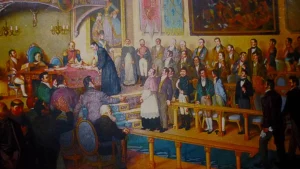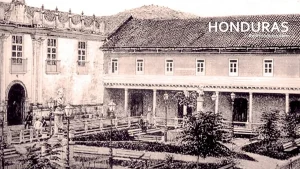Commercial activity in the colonial period of Honduras
The defeat of Lempira, the establishment of the bishopric, first in Trujillo and then in Comayagua, as well as the end of the struggle between rival Spanish factions, contributed to the colonization and increased economic activity in Honduras in the 1540s. A variety of agricultural activities developed in the country, including livestock farming and, for a time, the collection of large amounts of sarsaparilla. But the most important economic activity in 16th-century Honduras was the export of gold and silver.
The mining activity gave Gracias such importance that in 1543 it became the capital of the Audiencia de los Confines, created by Charles I and covering all of Central America. This decision created resentment in the more populated centers of Guatemala and El Salvador.
In 1549, the capital of the Audiencia was moved to Antigua, Guatemala, and Honduras was then governed by this Audiencia until 1552, and later came under the jurisdiction of the Captaincy General of Guatemala.
In 1540, gold and silver were discovered in the Guayape River valley. This contributed to the decline of Gracias and the rise of Comayagua as the main center of Honduras. The demand for labor increased, accelerating the decimation of the native population. As a result, slaves from Africa were introduced into the country. Other gold deposits were found near San Pedro Sula and the port of Trujillo.
Mining production began to decline in 1560, along with the importance of Honduras. In early 1569, new silver discoveries briefly revived the economy, leading to the founding of Tegucigalpa, which soon began to rival Comayagua as the most important city in the province. The silver boom reached its peak in 1584, and economic depression returned shortly after. Mining efforts in Honduras were hindered by a lack of capital, labor, and the difficulties of the terrain. Mercury, vital for silver production, was scarce, in addition to official negligence.
Throughout much of the 19th century, the Honduran economy attempted to boost itself through cattle and later agriculture, but without positive results. In the latter part of that century, economic activity accelerated with the exploitation of precious metals. The most important mines were located in the mountains surrounding the capital (Tegucigalpa), which were owned by the New York and Honduras Rosario Mining Company (NYHRMC).
Silver was the main metal extracted, accounting for about 55 percent of exports in the 1880s. However, the positive effects of mining on the Honduran economy were very few. Mining companies built some infrastructure, and monetary restrictions on trade were reduced during this period. However, the mining industry never fully integrated into the rest of the Honduran economy. The mining companies employed a small workforce and provided little to no income to the government, in addition to using imported mining equipment.




